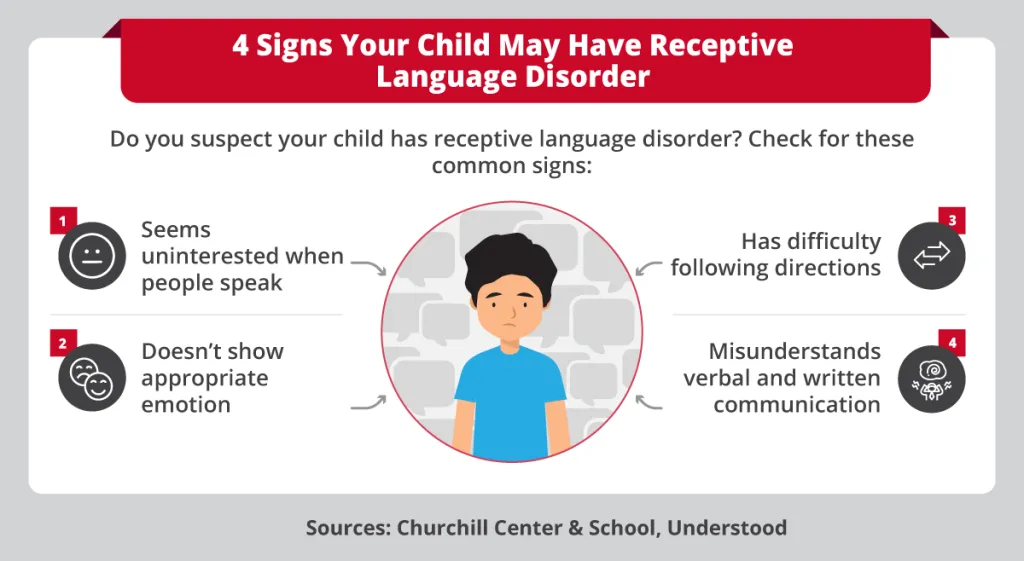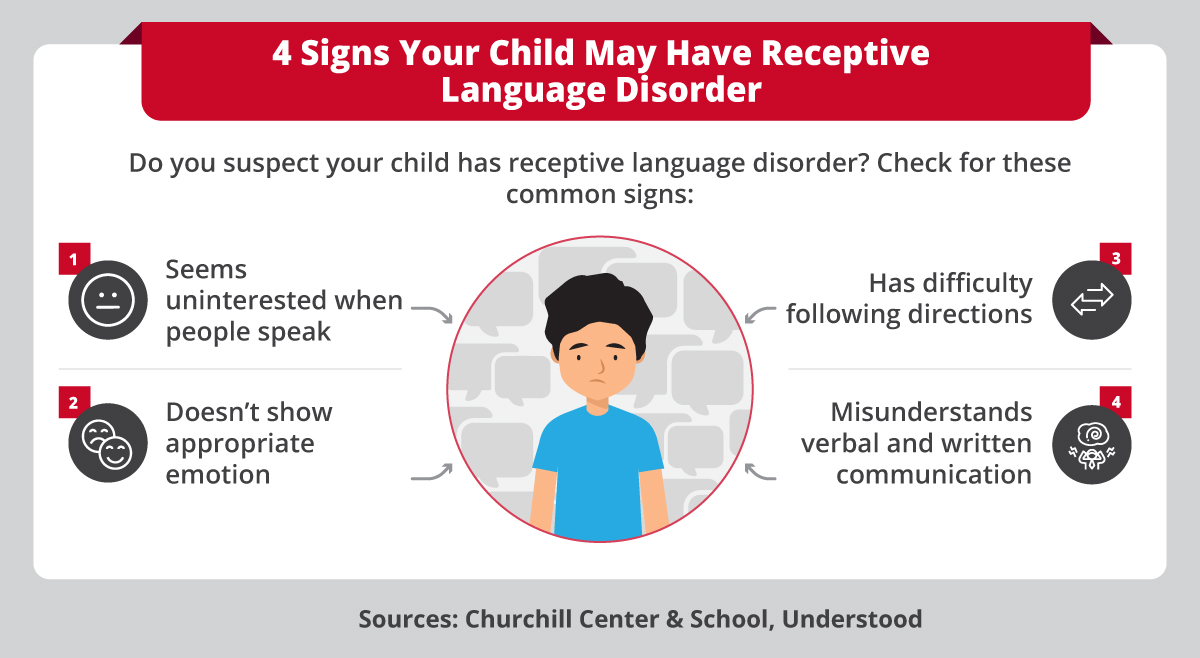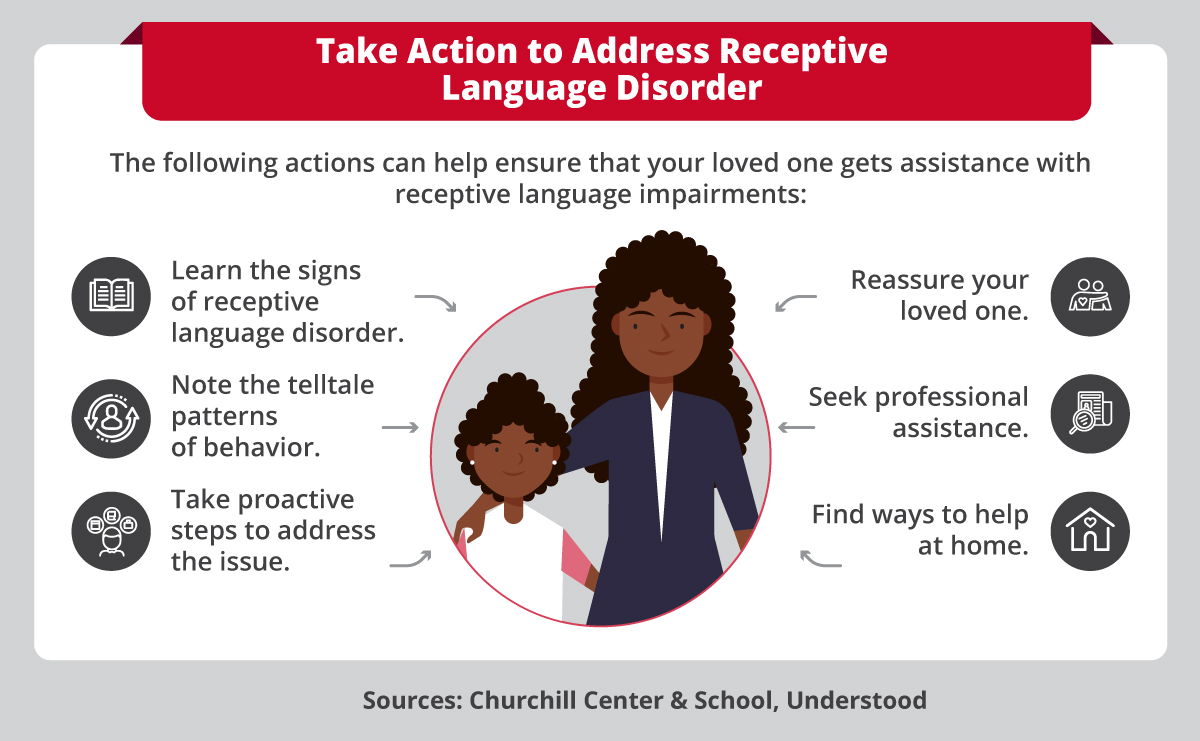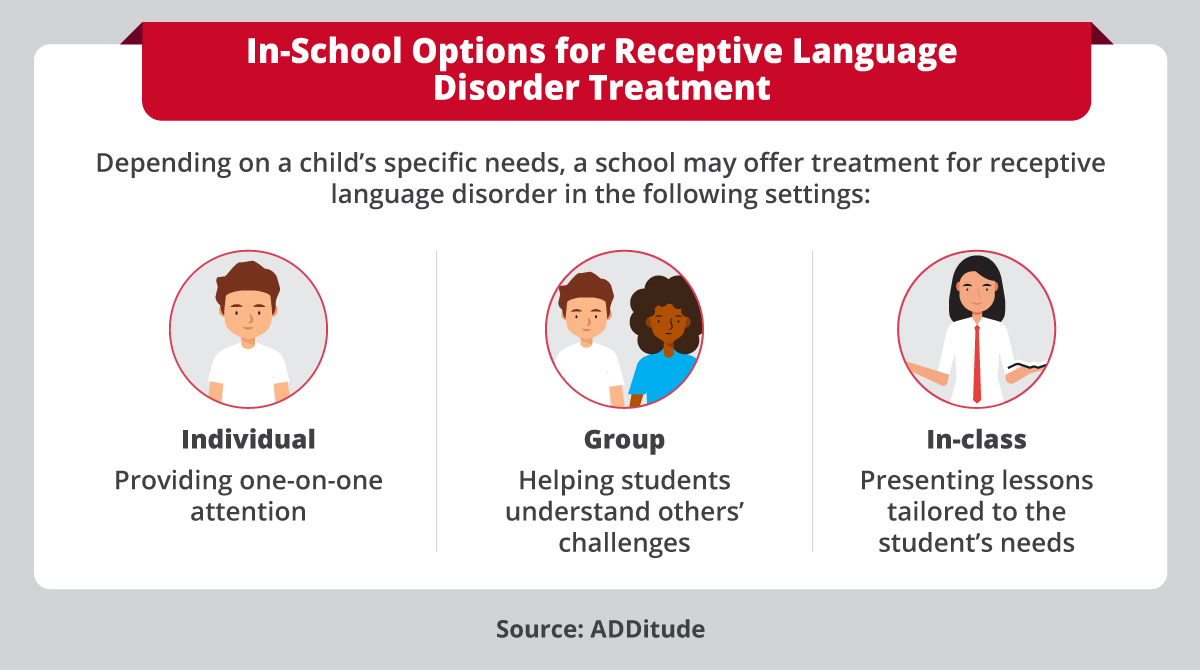Receptive Language Disorder Strategies to Improve Speech

Table of Contents
- What Is Receptive Language?
- How Do You Identify Receptive Language Disorder?
- Strategies to Improve Receptive Language Disorder
- Receptive Language Activities
- What Types of Receptive Language Therapy Exist?
- Be Proactive in Addressing Receptive Language Disorder
Children are born ready to learn a language — and, by age 5, most people can easily express themselves and understand others.
However, for people with language disorders, communicating with others is a challenge that can lead to difficulties at school and work, during social interactions, and in overall well-being. One type of language impairment is receptive language disorder.
Receptive language is the ability to comprehend other people’s words and actions. People with receptive language disorder often find it difficult to understand questions, follow directions, and participate in conversation.
Receptive language disorder is often a lifelong condition, but early recognition of its symptoms and quick action to address them can yield improvements.
What Is Receptive Language?
Language has two components: expressive and receptive. Expressive language is the language a person produces, and receptive language is what a person understands.
The term “receptive language” refers to processing the five domains of language:
- Morphology — Understanding how small changes in words change their meaning
- Phonology — Distinguishing between different speech soundsPragmatics — Recognizing the meanings and feelings the written and spoken words express
- Semantics — Comprehending vocabulary
- Syntax — Following the order of words in spoken or written communication
Use of Receptive Language
Receptive language is at work in processing a wide variety of spoken and written communication as well as behavior. It relies on an understanding of concepts related to shape, size, time, color, and grammar. Following are some examples of the use of receptive language:
- Following a routine for performing actions
- Listening and understanding when someone speaks
- Deciphering what behavior, words, or sounds signify
- Reading and comprehending written materials and signs
- Identifying pictures and objects
What Is Receptive Language Disorder?
Language disorder is a learning disability related to communication. The three types of language disorder follow:
- Receptive language disorder, sometimes called language comprehension deficit, can make it difficult to understand what others are saying or doing and to form social connections.
- Expressive language disorder is a condition in which a person has difficulty communicating a message when speaking.
- Mixed receptive-expressive language disorder is a condition in which a person has difficulty with understanding others and expressing themselves.
Receptive language disorder can occur in toddlers, children, and adults. The exact cause of the issue is unknown, but it can be the result of genetic factors, such as autism or birth defects, and environmental factors, such as lack of exposure to speech because of neglect. Receptive language disorder in children is more likely to occur if a parent or sibling experiences the condition.
The following issues can also lead to receptive language disorder:
- Vision impairment — Inability to see visual cues
- Hearing impairment — Decreased ability to listen to language
- Attention disorders — Lack of focus on conversation
For people who lose the ability to understand language in adulthood, the disorder is often the result of a brain injury or tumor. This condition is called receptive aphasia.
Receptive language disorder generally isn’t linked to intelligence, and it often doesn’t fade away on its own.
How Do You Identify Receptive Language Disorder?
No one set of behaviors always indicates receptive language disorder. Some potential signs exist, however. These behaviors may occur before children start kindergarten, but they often appear later than signs of expressive language disorder.
Identifying Receptive Language Disorder in Children
Some key behaviors can point to issues with receptive language in children. Following are some actions that may be difficult for children of various ages who have receptive language disorder:
- Prekindergarten: Listening; identifying objects; remembering names; taking turns; following directions; and identifying colors, numbers, and letters
- Grades kindergarten to 2: Answering questions, acting appropriately for a situation, completing tasks, and focusing on others who are talking
- Grades 3 to 5: Responding when people speak, using age-appropriate vocabulary, waiting their turn to speak, and making statements only once
- Preteen and teen: Asking questions or participating in class discussion, following the larger context of written and spoken communication, comprehending the meaning of statements, understanding jokes, and participating in extracurricular activities and clubs

Do you suspect your child has receptive language disorder? The Churchill Center & School and Understood recommend checking for these common signs: 1. Seems uninterested when people speak; 2. Doesn’t show appropriate emotion; 3. Has difficulty following directions; 4. Misunderstands verbal and written communication.
Identifying Receptive Language Disorder in Adults
Adults with receptive language disorder can have problems with social interaction. Activities such as the following can be difficult for adults with this condition:
- Following conversations
- Answering questions about conversations that just occurred
- Understanding the language others use
- Responding to others’ questions
- Completing word-finding problems
- Comprehending the meaning behind statements
- Interacting with others
- Participating in social events
Strategies to Improve Receptive Language Disorder
Individuals who suspect a loved one might have a receptive language disorder should take prompt action to confirm a diagnosis and seek help. With the right treatment, people with this condition can learn to communicate effectively and live full lives. Development of receptive language skills is critical in helping people build strong self-esteem through connecting with others, building relationships, and succeeding in school and work.
If a professional diagnoses the disorder, various receptive language disorder strategies are available to assist those with the issue.
How to Seek a Receptive Language Disorder Diagnosis
To ensure a person who may have receptive language disorder gets help as soon as possible, individuals should trust their instincts and get feedback and assistance from others. Steps to seeking a diagnosis include:
- Learning the possible signs and behaviors of the disorder
- Asking others, such as teachers, whether they’re noticing any telltale signs
- Being proactive, acting on suspicions that the loved one has the disorder
- Seeking the assistance of a professional, such as a primary healthcare provider; a speech therapist; and, in the case of serious behavioral problems, a psychologist
How Speech-Language Professionals Diagnose Receptive Language Disorder
When evaluating patients for receptive language conditions, medical professionals and speech therapists perform various tests to rule out issues such as hearing and vision problems. For people who speak multiple languages, speech therapists evaluate receptive language in all those languages but focus on the primary language for testing. In some cases, a neuropsychologist examines the individual for cognitive issues.
Following are some typical tests for diagnosing receptive language disorder:
- Hearing tests: To determine whether hearing problems are hampering the individual’s ability to process verbal communication
- Language comprehension tests: To compare comprehension abilities to the expected language comprehension for someone that age
- Observational tests: To see how the individual interacts with others in different settings
- Vision tests: To establish whether issues with sight are causing the communication problems
- Psychological tests: To uncover potential cognitive issues
Once a professional identifies the issue, implementing strategies to improve receptive language disorder is critical.

The following actions can help ensure your loved one gets assistance with receptive language impairments, according to the Churchill Center & School and Understood: learn the signs of receptive language disorder; note telltale patterns of behavior; take proactive steps to address the issue; reassure your loved one; seek professional assistance; and find ways to help at home.
How to Assist Someone with Receptive Language Disorder
Key practices can make understanding spoken and written communication easier for those diagnosed with receptive language disorder. When interacting with children or with adults, the following actions can improve communication:
Making Communication Easier for Children with Receptive Language Disorder
To help children understand as they’re reading or when others are speaking, incorporate practices that encourage focus and listening. Some ways to help children struggling with receptive language disorder at school and at home include:
- Looking them in the eye when speaking
- Being positive and compassionate
- Using short and simple instructions
- Confirming that they understand the need to listen
- Eliminating distractions
- Encouraging them to ask others to repeat themselves if necessary
Using email or texts, whenever appropriate, can be helpful for older children who find verbal communication difficult.
Making Communication Easier for Adults with Receptive Language Disorder
Communication at home and in the workplace is a concern for adults with receptive language disorder. To help adults with this issue communicate effectively, take steps such as the following:
- Communicate in writing when possible, allowing time for well-thought-out responses.
- Provide advance notice of speaking expectations, allowing the individual to prepare remarks and anticipate questions.
- Send the individual an agenda for activities such as meetings, helping the person with receptive language disorder prepare mentally for discussion topics.
- Offer the individual plenty of time to speak, allowing for thinking through comments.
Receptive Language Activities
Efforts focused on strengthening receptive language skills are valuable for all toddlers and children as well as adults. These activities range from having simple conversations to telling jokes.
Receptive Language Activities for Toddlers and Children
Work to strengthen receptive language should begin early, using activities such as games, reading, and role-playing. Following are some receptive language activities for toddlers and children:
- Reading picture books and pointing to objects
- Playing games with predictable directions, such as “Simon Says”
- Playing “I Spy” and naming items to find
- Putting together jigsaw puzzles and describing them
- Participating in role-playing activities that emphasize appropriate interaction
- Making observational comments about what they’re doing and asking questions
- Having frequent, simple conversations
- Asking them to look at someone who’s speaking and not interrupt
- Encouraging them to ask others to repeat themselves if necessary
- Building on the complexity of instructions as they master them
Receptive Language Activities for Adults
For adults, receptive language problems often occur as a result of injury or stroke. Following are some activities to practice to strengthen receptive language skills in adulthood:
- Pointing to objects and body parts
- Following increasingly more challenging directions, building from directions with one step
- Responding to progressively more complex questions, starting with yes-or-no questions
- Using single words and phrases and building to paragraphs in communication
- Practicing telling jokes to encourage understanding
What Types of Receptive Language Therapy Exist?
Treatment options for receptive language disorder vary according to the needs of the individual experiencing the problem. From in-home activities that a speech therapist prescribes to therapy sessions conducted in office settings, the following can help address receptive language concerns:
- Speech therapy, one on one or as part of a group
- Classes or support programs at school
- Psychological treatment for serious behavioral problems
- Family activities as prescribed by a speech-language professional
When students with receptive language disorder receive treatment at school, they might do so on an individual basis for severe cases, in group therapy for young children, or through team-based teaching during class.

Depending on a child’s specific needs, a school may offer treatment for receptive language disorder in the following settings, according to ADDitude: individual — providing one-on-one attention; group — helping students understand others’ challenges; and in-class — presenting lessons tailored to the student’s needs.
Types of Receptive Language Therapy for Children
Speech-language professionals can employ various therapies to treat receptive language issues in children. These therapies generally fall into one of the following categories:
Vocabulary Development
Language intervention activities can expand the child’s vocabulary to ensure the vocabulary is at an age-appropriate level. A speech therapist may speak to and play with the child to help connect words to meanings. These activities allow the child to practice words and verbal interactions, often emphasizing words that can have multiple meanings while using them in sentences.
Multisensory Exercises
Multisensory techniques for treating receptive language disorder engage hearing and all the other senses. This approach to communication promotes neurological connections to enhance understanding.
Learning Assistance
Receptive language therapy can also teach children strategies that can help them during class activities. These strategies include asking individuals to repeat what they said and practicing following increasingly complex directions.
Types of Receptive Language Therapy for Adults
Adults experiencing problems with receptive language typically receive therapy that focuses on problem-solving, memory, and organization. They also learn tactics to use in social situations to improve communication, such as looking people in the eye.
How Long Do People Need Receptive Language Therapy?
The length of receptive language therapy varies according to factors such as the severity of the condition and how committed the individuals and their families are to following prescribed steps for addressing the issue.
For children with receptive language disorder, the condition may improve with age — or it may improve but require continued therapy into adulthood. Adults whose disorder is due to brain injury or stroke may see improvement in communication as they recover from the injury, lessening the need for therapy. Among the factors that can affect how long an individual requires receptive language therapy are:
- Severity of the disorder
- Age
- Frequency of therapy
- Other medical conditions
Resources to Learn More About Receptive Language Disorder
Various resources are available to individuals seeking details about receptive language disorder. The following sources offer articles, research, and tools about receptive language and how to address problems with it:
- A Day in Our Shoes — A Day in Our Shoes, a website from special education advocate Lisa Lightner, provides expert information, such as definitions related to language disorders; strategies for addressing these disorders, including receptive language disorder; and Individualized Education Program (IEP) components for children with language disorders.
- ADDitude — ADDitude provides guidance and support for those living with attention deficit hyperactivity disorder (ADHD). Among its materials are information about language disorders, such as receptive language disorder, that commonly occur alongside ADHD.
- American Speech-Language-Hearing Association — ASHA, a professional organization for the speech-language pathology community, offers research and publications that provide an in-depth look at various language disorders. ASHA’s website also includes resources to help individuals who are coping with these disorders, including a ProFind tool to seek professional help.
- Centers for Disease Control and Prevention — The CDC’s site includes a section about speech and language disorders in children, offering tips for working with children to encourage language development and finding help for children with speech and language disorders.
Be Proactive in Addressing Receptive Language Disorder
People who notice signs of receptive language disorder in a loved one should act promptly to address the issue. Difficulty listening, comprehending conversations and written materials, and following directions are a few indicators of potential receptive language issues.
Quickly implementing receptive language disorder strategies for treatment — including therapy from a speech-language professional — can put those struggling with the condition on the path to better social connections, greater success in school and work, and healthier self-esteem.
Infographic Sources
ADDitude, “How to Treat Language Processing Disorders”
Churchill Center & School, What Is a Language Disorder?
Understood, “I Think My Child Has Receptive Language Disorder. Now What?”
Understood, “Trouble With Receptive Language: What You’re Seeing”

